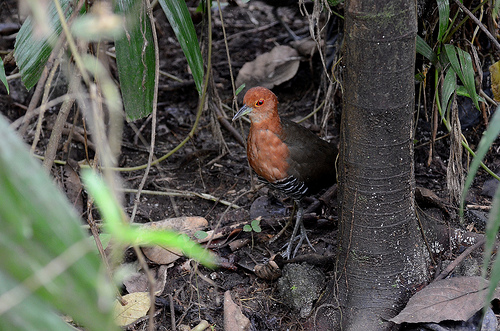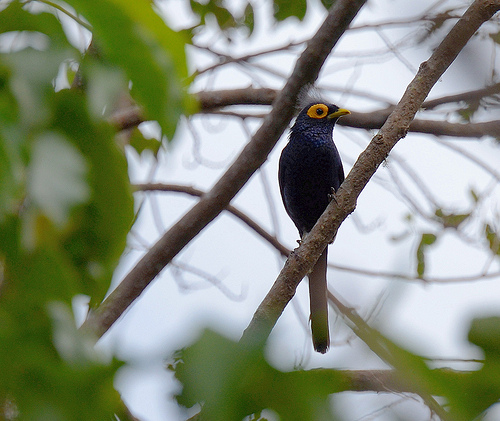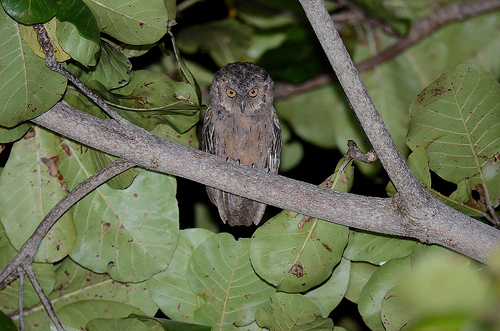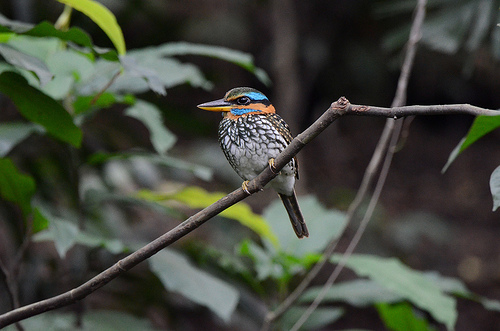
Custom tour to Mindanao, Palawan and Luzon from 10 November - 23 November
Leader: Bram Demeulemeester
Participant: Bryan Gieszl

Philippine Frogmouth
An early morning flight took us to the new airport of Cagayan De Oro in Mindanao. As soon as we arrived, we transferred to the base of Mt.Kitanglad where our local guide and porters where waiting for us. We made our way up to the Del Monte Lodge which would be our home for the next three nights. We started our birding on the very cloudy afternoon that greeted us, hoping for improved weather conditions for the next two days. Despite the dark grey afternoon, we checked out the birds near the lodge and we saw Philippine Cuckoo-Dove and got good views of Yellow-breasted Fruit-Dove, while several Philippine Hanging-Parrots where more often heard than seen. The group also got nice views of Whiskered Tree Swift before we all focused our attention on a small bird flock holding several of the more common species such as Black-and-Cinnamon Fantail, Sulphur-billed Nuthatch, and the very common Philippine Bulbul. Also seen in the flock were Mountain White-eye, Buzzing Flowerpecker, and Turquoise Flycatcher. Towards dusk, the Bukidnon Woodcock showed up several times very well. Later that evening, near the lodge, we were alerted by the calls of the Philippine Frogmouth that showed very nicely after several minutes of waiting. The prolonged views of the famous Frogmouth ended our first afternoon birding on the mountain.
Apo Myna
We woke up to a dark morning but were alerted by the calls of a Blue-capped Kingfisher. After some searching, we got some stunning views of the bird. With some rain, we made our way up the mountain toward the Eagle viewpoint. Along the way, we were able to see Mindanao Hornbill, Elegant Tits, Negros Leaf Warblers, Tawny Grassbird, plenty of Cinnamon Ibons, as well as several groups of Short-tailed Starlings. We also got scoping views of the bizarre-looking Apo Myna.
Further along the way up, we got several stunning views of the Stripe-breasted Rhabdornis, a McGregor’s Cuckoo Shrike, and plenty of Olive-capped Flowerpeckers. We also saw several Eastern Yellow Wagtails and Grey Wagtails in some open fields.
We arrived at the Philippine Eagle viewpoint and waited several hours, hoping that the rain would stop and some sun would show. Unfortunately, that didn’t happen that day though we did get several in-flight views of Mindanao Racquet-tails. We decided to make our way down towards the lodge for some late afternoon birding. We saw Rufous-headed Tailorbirds, more Cinnamon Ibons, and several Fire-breasted Flowerpeckers. Towards dusk, the Bukidnon Woodcocks alerted us again with their calls and were seen together with both Great-eared Nightjar and Philippine Nightjar. That evening, the skies started to clear out and we were hopeful for good weather the next day. Later that evening, we heard the calls of a Giant Scops-owl. After some searching, we had stunning views of this mega owl species. It was definitely a good way to end our first full day at Mt. Kitanglad.

Giant Scops-owl
Our second day finally gave us clear skies and sunny weather as we made our way up the Eagle viewpoint. Along the way, a Yellow-bellied Whistler showed up and we got nice views of the Grey-hooded Sunbird. As soon as we arrived at the viewpoint, it did not take us long before a Philippine Eagle was scoped, giving us long views although at a distance. Bryan even had the luck to see it is flight through the scope.
We made our way higher up the montane forest which proved to be very silent this time of year. We did see Amethyst Brown-Dove, several McGregor’s Cuckoo-shrike, more Apo Mynas, and a single Black-masked White-eye. We spent some time searching for the Apo Sunbird before it showed well for the group.
On our way back, we had scoping views of several Mindanao Racquet-tails and as we were nearing the lodge, saw the sky filled with Philippine Swiftlets. November is still a quiet month in Mt. Kitanglad but our trip still proved to be good for birding, despite of a single day of rain.
Palawan Flycatcher
The following day after our descent from Mt. Kitanglad, we took a plane to Palawan where we landed later that evening. We started birding early the next day, getting nice views of the Palawan Frogmouth that was calling just outside the resort we were staying in in Puerto Princesa City. It was a very good start to our endemic bird search on Palawan.
We made our way to the Balsahan Trail where we got several views of the main target species: the Palawan Flycatcher and the more obscure Melodious Babbler. There was plenty of bird activity along the trail by the river crossing, the water being much higher than usual. Here we saw Green Imperial-Pigeon, Chestnut-breasted Malkoha, Spot-throated Flameback, Palawan Drongo, and our first Blue Paradise Flycatcher of the trip. Many Palawan Crows were heard and few were seen. Ashy-fronted Bulbul, Palawan Blue-Flycatcher, and White-vented Shama all gave some splendid views. We also got a few sightings of the skulking Ashy-headed Babbler and the more common Pin-Striped Babbler. Long views of a single Hooded Pitta were more than welcome and several Yellow-throated Leafbirds where scanned higher up in the canopy. We got several glimpses of the Palawan Flowerpecker and got our first sighting of both the Lovely Sunbird and Pale Spiderhunter, to which we ended our successful early morning on the Balsahan trail.
On our way out of the Penal Colony, we made some stops along some rice paddies that was packed with bird life. Here we saw Grey Heron, Intermediate Egret, and Little Egret along with plenty Black-winged Stilts, Wood Sandpipers, Marsh Sandpipers, Common Greenshanks, a few Oriental Pratincoles, and some Red-necked Stints. Heading towards the main road, we were treated to views of a Crested Serpent-Eagle eating a snake. A short stop at the mangrove area resulted in quick views of the extremely beautiful Copper-throated Sunbird. We even had closer views of the bird at the sea front restaurant where we had our lunch. After that, we headed to Cowrie Island where we saw large groups of waders including several Greater and Lesser Sand-Plovers, Kentish Plovers, Terek Sandpipers, several Grey-tailed Tattlers, Whimbrels, and Ruddy Turnstones. We also got nice flight views of a Great-billed Heron. The island is home to the Mantanani Scops-owl which did not take too long to spot. At dusk, we made our way back to Puerto Princesa ending the day with the great views of this tiny owl species.
Mantanani Scops-owl
Early morning the following day, we made our way to Sabang Beach where we will be birding for the next two days. We made several stops birding along the way. Our first stop was very successful with prolonged scoping views of a male and female Red-headed Woodpecker. The sighting of these birds was more than a welcome as it is a very rare-encountered endemic species. Plenty of birds were spotted along the way towards Sabang on our several stops along patches of forest. Sightings include the common Green Imperial-Pigeons, Blue-naped Parrot, Chestnut-breasted Malkoha, Dollarbird, several views and one mega scoping view of the Palawan Hornbill, and Spot-throated Flameback. Great Slaty Woodpeckers also gave long scoping views of their bizarre behaviour. Ashy Drongo and Palawan Drongos were all well-presented during our walks along the road. We also saw Black-naped Monarch and more nice views of the stunning Blue-Paradise Flycatcher. Several Palawan Tits were also observed as well as Black-Headed Bulbuls, Palawan Bulbuls, and a few individual Sulphur-bellied Bulbuls. Also seen along the road were Rufous-tailed Tailorbird, Asian Fairy Bluebird, White-vented Shama, Yellow-throated Leafbird, Palawan Flowerpecker, Striped Flowerpecker, Purple-throated Sunbird, and Lovely Sunbird. Later in the afternoon, we were alerted by the calls of the Falcated Wren-Babbler, which we saw after some searching on a small side trail from the main road. Some Philippine Cockatoos were seen at the viewpoint in the evening. We were also ready for our nocturnal search for owls which resulted in some mega views of the elusive Palawan Scops-owl, a very nice way to end our day.
We left early the following morning and headed towards the St Paul's Subterranean River National Park to search for the famous, and now getting old, Palawan Peacock-Pheasant. The bird proved to be even friendlier than ever. It is a stunning bird and one of the most wanted species these days in the Philippines. Several Philippine Scrubfowls were also seen as well as two Stork-billed Kingfishers waiting for prey at the entrance of the underground river. With plenty of Germain’s Swiflets and Palawan Swifts flying overhead, we made our way back to Sabang for a walk along the beach where we spotted three Malaysian Plovers.
Palawan Peacock-Pheasant
Soon, we were birding on the road again. We got nice and prolonged scoping views of a tiny-looking Besra, Black-chinned Fruit-Dove, while Philippine Cockatoos gave even closer views and two Blue-headed Racquet-tails flew overhead very fast. A mixed flock of Fiery Minivet, Dark-throated Oriole, Palawan Tit, Velvet-fronted Nutchatch, Ashy-fronted Bulbul, Grey-streaked Flycatcher, Yellow-throated Leafbird, and both Palawan and Striped Flowerpeckers were observed. At dusk, we had some very close encounters with a Large-tailed Nightjar.
By now, we had seen all the possible endemics on Palawan with the exception of the Palawan Striped-Babblers, which live in the higher mountains in the south. We made our way back towards Puerto Princesa, birding along the way. We ended our Palawan journey with some stunning scoping views of several Blue-headed Racquet-tails. We took an evening flight back to Manila for an overnight stay.
Palawan Scops-owl
We left very early the next morning for a visit to the La Mesa Eco Park in Quezon City. Here we spotted a Red-bellied Pitta at first light. A Barred Rail also crossed the trail inside the mini forest in the park. Later on, we had very long views of the stunning Spotted Wood Kingfisher. Bryan also had close looks at an Indigo-banded Kingfisher and we observed several juvenile Red-bellied Pittas hopping around in the trail. We also saw Philippine Pied Fantails, Artic Warbler, Lowland White-eyes, and the Grey-backed Tailorbird that morning, including several very friendly Ashy Thrushes. Two stunning views of Slaty-legged Crakes made our visit to the park complete before we made our way south of Manila to Mt. Makiling.
We arrived at Mt. Makiling at the university campus in Los Banos where we had one Plain Bush-hen making its way in the scrub along the road. Most of our afternoon birding was concentrated along the open fields that resulted in several views of the endemic Spotted Buttonquail and one Slaty-breasted Rail was seen on the trail and gave some rather good scoping views. Other species seen were Red-Collared-Doves and Philippine Hanging-Parrots, while a Red-crested Malkoha was observed making its way slowly toward the top of a tree. We also saw plenty of Coppersmith Barbets sitting on the branches of a dead tree. Also seen on the campus grounds were Large-billed Crow, House Swift, Striated Swallows, and several Asian Palm Swifts.

Slaty-legged Crake
Our first early morning on Mt.Makiling started with nice views of the Philippine Scops-Owl. We also got some very brief flight views of the Luzon Hawk-Owl before we made our way slowly up the mountain towards the hot springs. Along the way, we spotted more Red-crested Malkoha and a single Scaly-feathered Malkoha. We also had scoping views of several Luzon Hornbills feeding on a fruiting tree and a Luzon Flameback were also seen. Some Bar-bellied Cuckoo-shrikes and a group of wintering Ashy Minivets were spotted in the higher forest canopy. We also had stunning views of the sometimes very tricky White-browed Shama. On the way back from the hot spring, the group saw a Philippine Trogon and Lovely Sunbird. In the afternoon, we visited some open fields again and saw some Oriental Skylark and Paddyfield Pipit. We also had some prolonged views of the very tiny Barred Buttonquail and ended our day with a nice view of a Stripe-headed Rhabdornis.
We proceeded very early the next morning to the Candaba Marsh, which was our morning stop over on our way to Subic Bay. Lots of wintering ducks have arrived and we scoped Spotted Whistling-Ducks, lots of Philippine Ducks, Northern Pintails, Northern Shovelers, hundreds of Garganeys, and some Tufted Ducks. We also had nice views of Yellow, Cinnamon, and Black Bitterns as well as Black-crowned Night-Herons and Buff Banded Rails. A single Philippine Swamphen was also seen. Several wader species were spotted along the many muddy rice paddies including Kentish Plovers, Black-winged Stilts, Wood Sandpipers, Common Sandpipers, Common Greenshanks, Marsh Sandpipers, Long-toed Stints, plenty of Arctic Warblers, and we got nice views of the skulking Middendorff’s Grasshopper-Warbler. We then made our way toward the last destination of the tour for a two-night stay in Subic Bay.
Spotted Wood Kingfisher
We saw Philippine Serpent-Eagle on both days we were in Subic and we had great scoping views of the Philippine Hawk-Eagle. A single Philippine Falconet was seen on our first afternoon. Other species seen include Yellow-breasted Fruit-Dove and plenty of Green Imperial-Pigeons. The group had very nice scoping views of Guaiaberos, several Green Racquet-tails, as well as Blue-naped Parrots. Large groups of Red-crested Malkohas were seen as well as some Rufous Coucals plus a few Philippine Coucals. We also had two brief views of the Luzon Hawk-Owl and one short view of the Chocolate Boobook showing its hawking behaviour. Several Philippines Scops-Owl were heard only. We also saw Grey-rumped Swiftlets, which is a potential split from the Glossy Swiftlet. Other species seen include Whiskered Treeswift, Brown-breasted Kingfisher, several Rufous-crowned Bee-eaters, Dollarbirds, Luzon Hornbills, Philippine Pygmy Woodpeckers, White-bellied Woodpeckers, many views of Luzon Flamebacks and Northern Sooty Woodpeckers, as well as Bar-bellied Cuckoo-shrikes and several Blackish Cuckoo-shrikes. Another group of wintering Ashy Minivets were seen including lots of Luzon Balicassiaos, and the very common Philippine Bulbuls. Trilling Tailorbirds were heard only while plenty of Coletos were spotted and more were heard. Subic Bay was a bit silent compared to the months of February to May and with one of the main roads towards Hill 394 closed to the public, it is now quite challenging to spot the White lored-Oriole and White-fronted Tit. Around noon on our second day at Subic, we made our way back to Manila.
St Paul's Subterranean River National Park
See our previous tour report to Palawan and Subic Bay and Mt.Makiling.







